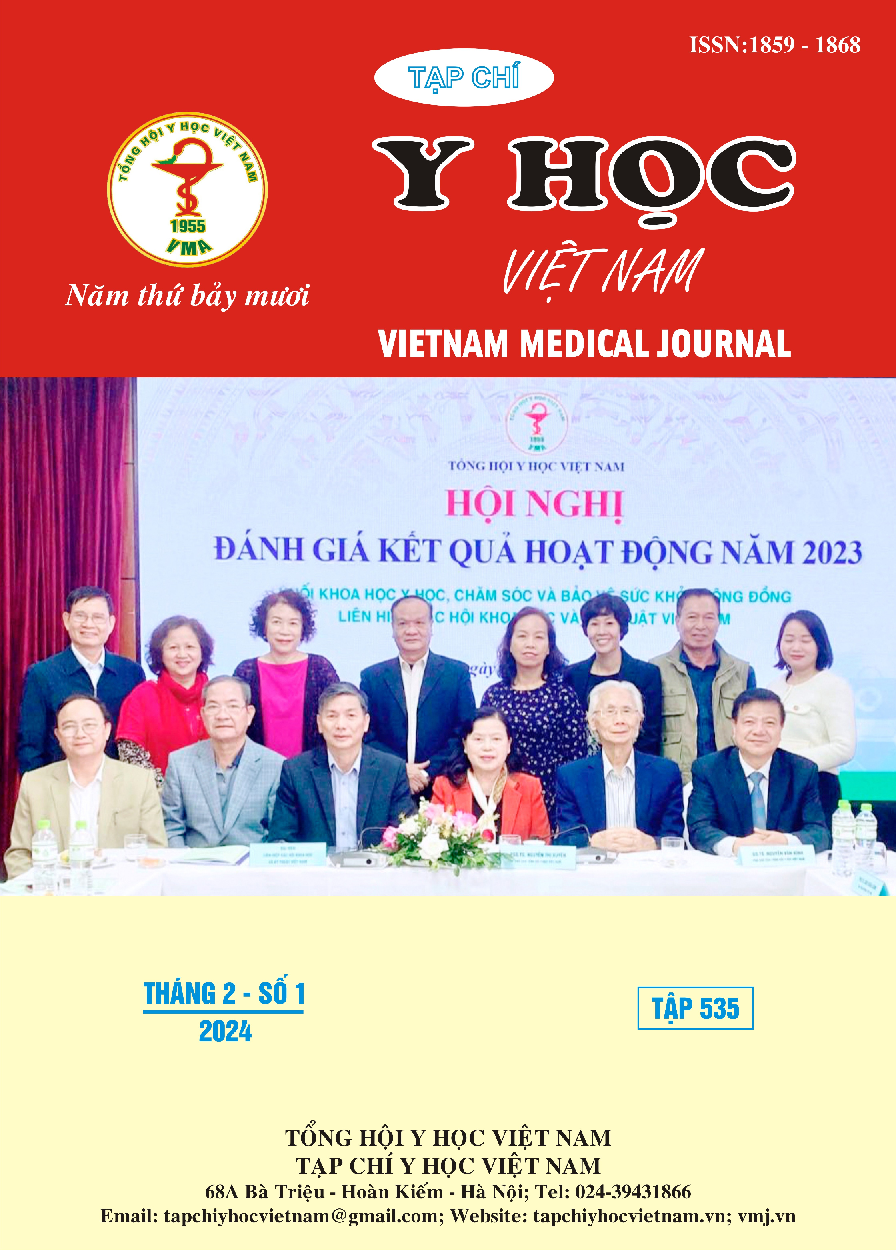CHARACTERISTICS OF MECHANICAL VENTILATION AND FACTORS ASSOCIATED WITH TREAMENT OUTCOMES OF CHILDREN AGED BEYOND NEONATAL AGE AT VENTILATION AT PEDIATRIC CENTER, BACH MAI HOSPITAL FROM 2018-2022
Main Article Content
Abstract
Objective: To describe characteristics of mechanical ventilation and factors associated with treatment outcomes of children who required mechanical ventilation at Pediatric Center - Bach Mai Hospital from 2018 to 2022. Subjects and methods: This was a retrospective descriptive study of 265 children aged beyond the neonatal age who received mechanical ventilation at the Pediatric Center - Bach Mai Hospital from January 2018 to December 2022. Results: There were 265 children with an average age was 8,1 ± 5,2 years. Among them, 37,4% had underlying conditions; 31,3% required non-invasive mechanical ventilation, 17,0% needed invasive mechanical ventilation after failing non-invasive ventilation, and 51,7% required immidiate invasive mechanical ventilation. The most common cause of respiratory failure necessitating mechanical ventilation was respiratory disease (70,6%). The most common ventilation modes were SIMV (82,6%) and A/C (7,6%). Ventilation-related complications accounted for 15,1% of cases, with tracheal tube displacement being the most prevalent complication (13,6%). The average duration of mechanical ventilation was 167,5 ± 311,1 hours, and the weaning success rate was 87,3%. Several risk factors associated with an increased risk of unsuccessful weaning included having underlying conditions and multi-organ failure. Children with underlying conditions had a 3,41 times higher risk of unsuccessful weaning compared to those without underlying conditions, and children with multi-organ failure had a 4,38 times higher risk of unsuccessful weaning compared to those without multi-organ failure. Conclusion: Respiratory disease was the most common cause of respiratory failure necessitating mechanical ventilation, and the most common ventilation mode was SIMV. Most of the patients were successfully weaned from mechanical ventilation. It is very important to pay attention to children with underlying medical conditions and multi-organ failure during the care and treatment of ventilated patients.
Article Details
References
2. Vũ Thị Thu Nga. Nghiên Cứu Nguyên Nhân Thở Máy ở Trẻ Sơ Sinh và Một Số Yếu Tố Liên Quan Đến Kết Quả Thở Máy Tại Bệnh Viện Nhi Trung Ương. Luận văn Bác sĩ chuyên khoa I. Trường Đại học Y Hà Nội; 2017.
3. Vũ Quốc Bảo, Thạch Lễ Tín, Nguyễn Tất Thành. Đặc điểm viêm phổi liên quan thở máy tại khoa hồi sức tích cực và chống độc Bệnh viện Nhi Đồng 2. Y học thành phố Hồ Chí Minh. 2012; Tập 16(Số 4).
4. Vũ Hải Yến. Nghiên Cứu Nguyên Nhân và Một Số Yếu Tố Liên Quan Đến Thở Máy Kéo Dài Tại Bệnh Viện Nhi Trung Ương. Luận văn thạc sĩ y học. Trường Đại học Y Hà Nội; 2018.
5. Zhang Z, Tao J, Cai X, et al. Clinical characteristics and outcomes of children with prolonged mechanical ventilation in PICUs in mainland China: A national survey. Pediatr Pulmonol. 2023;58(5):1401-1410.
6. Farias J, Fernández A, Monteverde E, et al. Mechanical ventilation in pediatric intensive care units during the season for acute lower respiratory infection: A multicenter study. Pediatric critical care medicine : a journal of the Society of Critical Care Medicine and the World Federation of Pediatric Intensive and Critical Care Societies. 2011;13:158-164.
7. Phan Trọng Hiểu, Lê Hoàng Sơn, Võ Thị Khánh Nguyệt. Đặc điểm lâm sàng, cận lâm sàng, nguyên nhân và kết quả điều trị suy hô hấp ở trẻ sơ sinh có thở máy tại bệnh viện Nhi Đồng Cần Thơ
8. Yaman A, Kendirli T, Ödek Ç, et al. Efficacy of noninvasive mechanical ventilation in prevention of intubation and reintubation in the pediatric intensive care unit. J Crit Care. 2016;32:175-181.
9. Mayordomo-Colunga J, Medina A, Rey C, et al. Non invasive ventilation after extubation in paediatric patients: a preliminary study. BMC Pediatr. 2010;10:29.
10. Fernandez-Zamora MD, Gordillo-Brenes A, Banderas-Bravo E, et al. Prolonged Mechanical Ventilation as a Predictor of Mortality After Cardiac Surgery. Respir Care. 2018;63(5):550-557.


